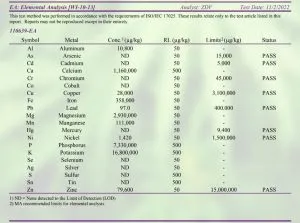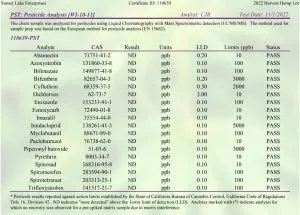No products in the cart.
How To Read A Certificate Of Analysis (COA)
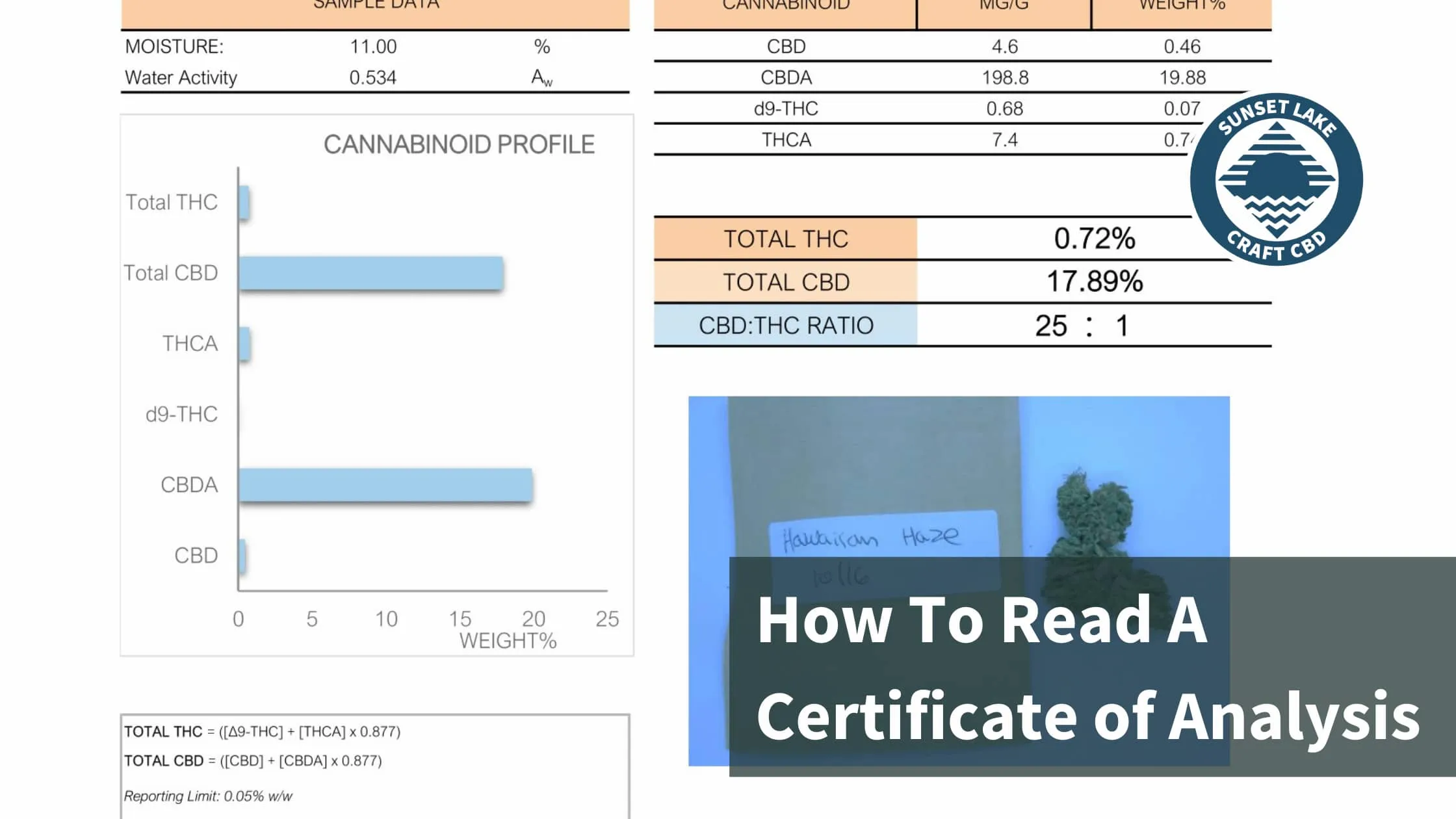
Key Takeaways
- Certificates of Analysis (COAs) are technical documents that ensure that your product contains the advertised level of CBD. Learning how to read your certificate of analysis will make you a better shopper.
- COAs may contain up to four major parts: lab information, cannabinoid analysis, terpene analysis, and contaminant analysis.
- From a legal standpoint, certificates of analysis also ensure that your product contains less THC than set forth by the 2018 Farm Bill
Table Of Contents
- What Is A Certificate Of Analysis?
- How To Read Your Certificate Of Analysis
- Step 1: The Header
- Step 2: The Cannabinoid Profile
- Step 3: Terpene Analysis
- Step 4: Heavy Metals, Pesticides, & Fungi
- FAQs About COAs
If you’ve ever purchased CBD products, hemp flower, or any cannabis products, you may have seen or been given a certificate of analysis. Often shortened to COAs, certificates of analysis are technical documents from an accredited third-party lab that confirm that a regulated product meets certain specifications.
We can all agree that knowing about your product’s potency and safety is important, but sometimes, these documents can be hard to read. By the end of this post, you will hopefully know how to read your certificate of analysis.
Note that in this post, we’ll be using a few older Sunset Lake CBD product certificates of analysis as examples. You can find them in full in our Quality Tests directory here.
What Is A Certificate Of Analysis?
A certificate of analysis is a technical document provided by a third-party lab that will detail your hemp product’s
- Name
- Cannabinoid Profile
- Total Potency
- Batch Number
- Testing Matrix
- Testing Date
More in-depth certificates, called full-panel COAs, will contain additional information like,
- Terpene Profile
- Moisture Content
- Contaminant Levels
- Heavy Metal & Pesticide Levels
The hemp industry uses COAs to confirm product potency, cannabinoid concentrations, and to ensure that their product isn’t “hot,” meaning that it contains less than 0.3% delta-9 THC by dry weight.
Here at Sunset Lake CBD, we test our products for potency, our sungrown hemp flower for terpene levels, and our harvest lots for any contaminants.
Where Do You Get A Certificate Of Analysis?
Farms and vendors, by default, should get their COAs from third-party labs. Sunset Lake sends its samples to a few different labs in the area. When you’re looking at your certificate of analysis, make sure that the lab that produced your document isn’t associated with the vendor or farm.
Why Is A Third Party Important?
Imagine you’re buying a used car. Many of us aren’t mechanics— we look at the car’s exterior and underneath for obvious problems, but would you really buy a car without getting the carfax or having your mechanic take a look under the hood? Probably not.
The same goes for CBD vendors. They’re probably telling the truth about their products, but every vendor should readily provide you with test results from a neutral third party.
Where To Find Your Certificate Of Analysis
If you’re buying CBD products and trying to find a COA for your product, there are a few places you’ll want to look.
- Attached to your product’s label via a QR code or batch number
- Online on the vendor’s website
- Or via customer support
How To Read Your Certificate Of Analysis
We’ve reached the meat of the post. For the rest of this post, we’ll reference the following certificates of analysis:
- 2022 Harvest Hemp Lot Testing
- 2022 Hawaiian Haze Hemp Flower
- 2024 1500mg Full Spectrum CBD Oil Tincture
Now, let’s break down our COAs section by section and figure out how to read a certificate of analysis.
Step 1: The Header
The header of your certificate of analysis should contain information about tests, by whom, and when. Let’s dissect our 2022 Harvest Hemp Lot COA, a sample of our plants from around our hemp field.
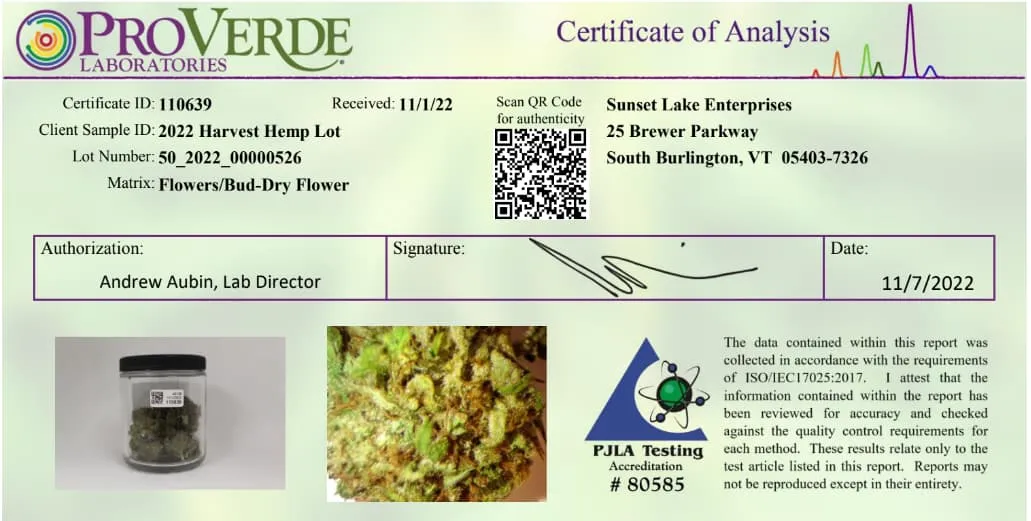
Starting from the top left and moving down, we have the following,
- Who conducted the test – The name of the lab that conducted the test will always be on a legitimate document. In our case, ProVerde Laboratories in Massachusetts ran this test.
- Certificate ID – This is the ID number assigned by the lab for internal purposes. Sometimes, hemp companies will reference this number, too.
- Client sample ID & lot number – We provide the laboratory with the client sample ID and lot number. The sample ID tells us what we’re testing, and the lot number is associated with our hemp cultivation license, the year, and which test this is in this calendar year.
- Matrix – This is the type of testing that the lab performed. For example, the lab tests smokable flower under the “dry flower” matrix and CBD gummies under their “edible” matrix. There is no one-size-fits-all CBD product potency test. For this certificate of analysis, we tested dry flowers from our field for the presence of heavy metals and pesticides, so they used the flower matrix.
- Date received – Most COAs will have at least two dates listed on their documents. One date will note when the sample arrived, and a second to show when the product was tested.
- Who ordered the test – That would be Sunset Lake Enterprises in this case. Our incorporation address is listed below.
- Analyst – For the laboratory’s record keeping, this field denotes which laboratory technician carried out the testing on the product. Lab Director Andrew certified these results.
- Image of the sample – The lab will almost always provide an image of the sample received. This is a check between the company ordering the test and the lab. If we find a discrepancy, we can talk to the lab and remedy it.
- Accreditation – For legitimacy, you should look for tests from accredited labs. ProVerde is an ISO-certified lab.
You’ll also notice that this header includes a QR code. Some labs move this around based on their certificate of analysis template. The QR code is included as a way for consumers to verify the validity of their COA. Using your smartphone, you should be able to use the QR code to find a digital copy of the COA.
Some other certificates may have slightly different information listed in their heading, but you should be able to find all of the info listed above somewhere on your document. Let’s move on to the portion of the COA that should be present in all hemp and CBD COAs.
Step 2: The Cannabinoid Profile
The cannabinoid profile is the real meat and potatoes of CBD product COAs. This section will tell us what cannabinoids are present in our samples, their respective concentrations, and the total cannabinoid counts for the sample.
Let’s reference the cannabinoid profile for our 2022 Hawaiian Hemp Flower (ID number 110654) for the next few sections.
Hemp Flower Cannabinoid Profile
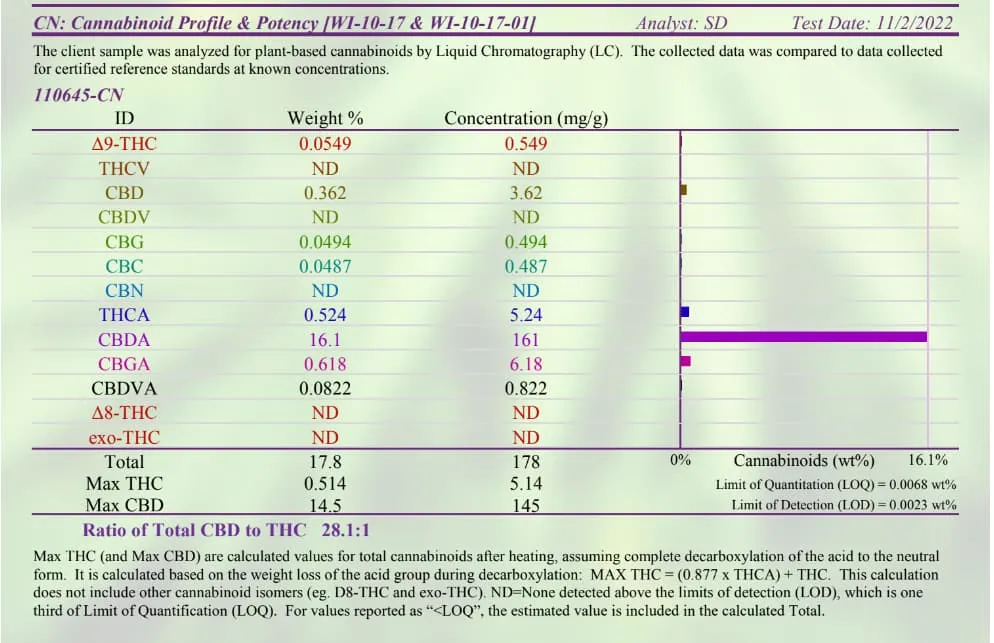
Under a short sentence about testing methods, you’ll notice that we have three columns:
- ID – This lists the cannabinoid in question.
- Weight % – This number will tell us what percentage of our sample’s weight is that cannabinoid.
- Concentration – This number tells us how many milligrams of each cannabinoid are in a gram of our sample.
In this section, we want to take notice of a few cannabinoids. Using some math, we can use CBD and CBDa to determine our sample’s total CBD content. We also need to verify that our product is a legal hemp product by looking at the delta-9 THC concentration. We see that our Hawaiian Hemp sample contains 0.05% delta-9 THC, which is below the 0.3% threshold set by the 2018 Farm Bill.
Hemp Flower Total CBD
Smokables, like our 2022 Hawaiian Haze, are more often than not “raw” products. That means they’ll contain higher concentrations of acidic cannabinoids like CBDa. CBDa turns into CBD via a process called decarboxylation, wherein it loses mass to become “activated” CBD.
To determine our Hawaiian Haze’s total CBD content, we have to mathematically convert the CBDa while also accounting for loss of mass. The equation looks like this:
([CBD] + [CBDa] x 0.877) = Total CBD 0.36% + (16.1 x 0.877)% = 14.5% Total CBD
This certificate of analysis says that after decarboxylation, our Hawaiian Haze flower should contain 14.5% CBD. Luckily, we can check our answer by looking at the bottom of the cannabinoid section. Here, we’ll see a small blocked-off section that lists total cannabinoid content, total THC content, and total CBD content.
Manufactured CBD Products
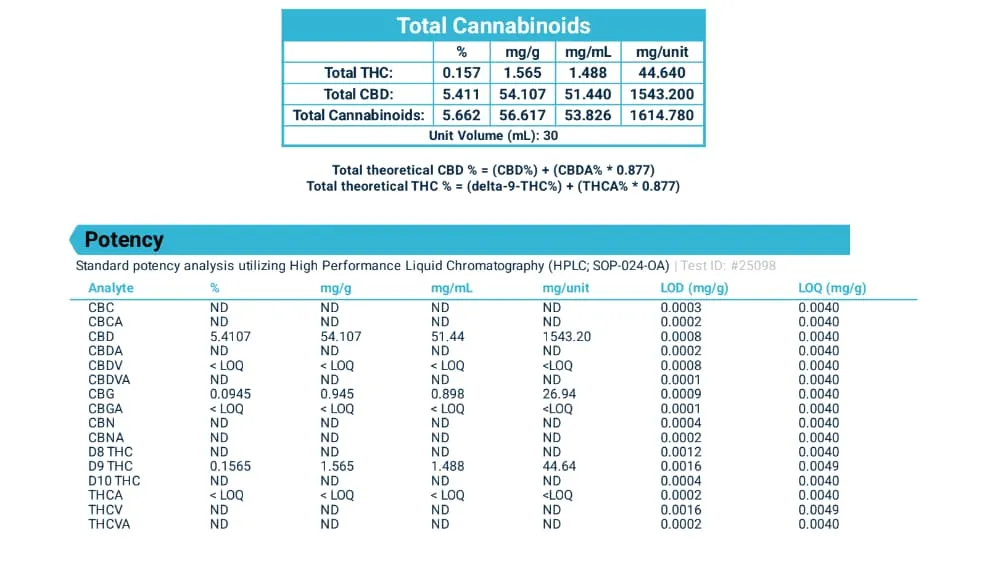
The above cannabinoid profile is from Sunset Lake CBD’s 2024 1500mg CBD Oil Tincture.
Our 1500mg CBD Oil Tincture contains 54.107mg per gram of oil. This lab’s CBD Oil COA is nice as it will tell us how much CBD we can expect to find in a mL of oil (a standard dose) and how much CBD a full bottle contains. If we didn’t have these columns, we would have to do a bit of math. Luckily, that’s what this post is about, so let’s do it.
- Step 1: A quick product lookup tells us our carrier oil, MCT oil, weighs 0.95 grams per mL.
- Step 2: Our 1500mg CBD Oil Tincture contains 30 mL of CBD-infused oil, so let’s multiply our total volume (30mL) by the weight of our oil (0.95g/mL). Our multiplication cancels out the mL variable, and we’re left with 28.5g.
- We need to multiply 28.5 grams by our “Total CBD” concentration (54.1mg/g) to find our total milligrams per bottle.
54.1mg/g x 28.5g = 1,541 mgThat’s a bit higher than the 1500mg mark but still within the allowed 10% (150mg) margin of error.
Determining THC Content
You’ll notice that in both of the CBD product COAs we just presented, delta-9 THC, is prominently featured on both. That’s because it’s the only cannabinoid specifically restricted in the 2018 Farm Bill because of its psychoactive properties. According to the Farm Bill, hemp and CBD products are only legal if derived from cannabis plants that contain “a delta9-THC concentration no higher than 0.3% by dry weight.”
Minor Cannabinoids
Depending on the depth of your certificate of analysis, you may also see other minor cannabinoids listed. Here’s what you might see:
- THCV (tetrahydrocannabivarin) – Similar to THC minus a few carbon chains.
- CBDV (cannabidivarin) – Similar to CBD in chemical makeup. Early studies suggest that CBDV could help with a number of maladies.
- CBG (cannabigerol) – A genetic precursor to both CBD and THC. Think of CBG as a cannabinoid stem cell.
- CBC (cannabichromene) – Considered one of the “big six” cannabinoids prominent in medical research. CBC isn’t intoxicating, but there is research into this phytocannabinoid’s medicinal benefits.
- CBN (cannabinol) – The “sleep cannabinoid.” As time passes, THC degrades into the non-intoxicating CBN.
- CBGa (cannabegeriolic acid) – The acidic form of CBG.
- D8-THC (Δ8 tetrahydrocannabinol) – Chemically different from D9-THC, but still intoxicating.
- exo-THC (exo-tetrahydrocannabinol) – Exo THC is an impurity formed during the synthesis of D9-THC.
Step 3: Terpene Analysis
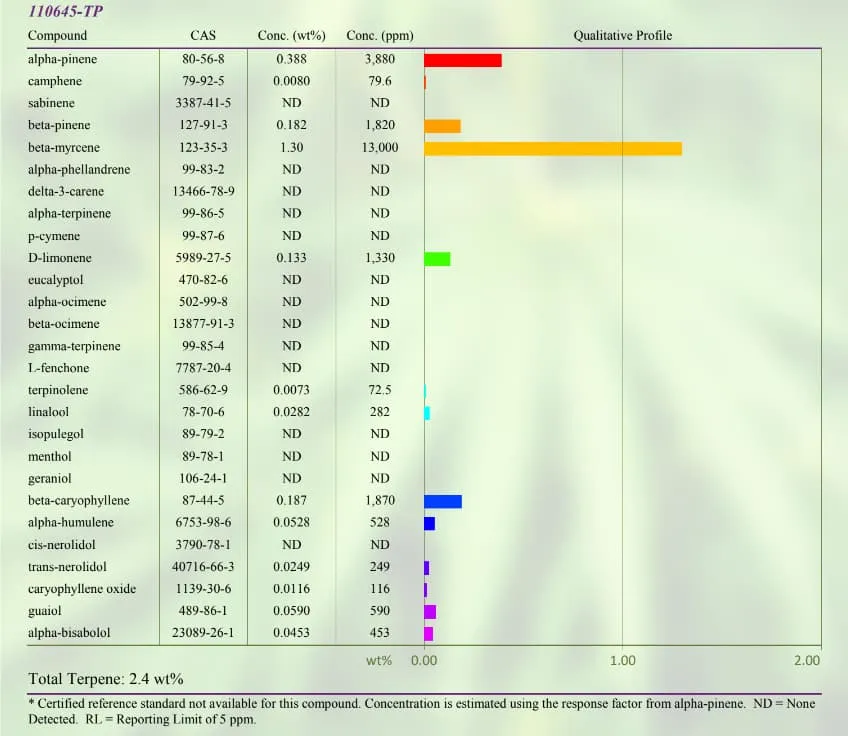
Some hemp flower certificates of analysis will also include terpene analysis. You won’t see them too much on manufactured products because the extraction and distillation process removes or destroys a lot of terpenes.
Terpenes are aromatic hydrocarbons found in many plants, not just hemp, and are responsible for some of the various therapeutic properties of hemp. Again, let’s look at our 2022 Hawaiian Haze Hemp Flower COA from ProVerde.
Notice that we have a list of two dozen or so terpenes visualized using a simple bar graph. Many terpenes are demarcated with “ND,” which means non-detectable. The most important column to look at here is the concentration weight %.
If you know how you respond to certain terpenes and are looking for specific profiles, this column will help you find a cultivar that best matches your needs. To learn more about these fun aromatic compounds, read our introduction to terpenes here.
Step 4: Heavy Metals, Pesticides, & Fungi
Above are the pesticide and heavy metal results from Sunset Lake’s lot test. Some comprehensive COAs, called “full-panel” certificates of analysis, will include reports on heavy metals, fungi, residual pesticides, and residual solvents in manufactured products.
The main column to pay attention to is the “Status” column on the right. If you ever see a “fail” in this column, avoid that product.
Below is a list of handy definitions that you’ll want to understand these reports better:
- Conc. – Concentration (µg/kg) will tell us how many micrograms of that substance are in each kilogram of our product. In this particular case, the columns marked with “ND” means that none of said metal is detectable in the flower.
- µg – Microgram (.000001 gram(s))
- kg – Kilogram (1000 grams)
- “RL” or reporting limits – A reporting limit is the detection limit for a sample after making moisture content adjustments. In other words, the sample may have trace amounts of the substance being tested for, but because of instrument limitations, the test cannot detect them.
- Limits – Limits are listed in parts per billion. These are the limits that are safe and acceptable according to the state of Massachusetts (where ProVerde is located). If the concentration exceeds this limit the sample will receive a “fail” in the status column.
- LLD – Similar to reporting limits, LLD stands for lower limit of detection. These are usually specific to laboratories and or states where that lab is located. On our pesticide analysis, the lower limit of detection is listed in parts per billion.
- ND – Not detected, meaning that the concentration doesn’t exceed the lowest limit of detection.
- Status – This column tells us whether or not our product passes the test and is safe for consumption. In this case, we pass with flying colors.
Heavy Metals
Heavy metals are present in all soil everywhere to varying degrees. Because of this unavoidable fact, we have established safe consumption limits for heavy metals.
Hemp and cannabis plants are also great for soil health because they leach heavy metals out of the soil. However, because they clean up so well, we have to take extra care to ensure that our hemp flower doesn’t exceed the limits set forth by state and federal agencies.
Pesticides
Thanks to the large seed and chemical manufacturers controlling our food systems, pesticides are nearly unavoidable in modern agriculture. We try to buck this trend by going completely pesticide free and instead using helpful bugs to control unwanted bug populations. You’ll see on our certificate of analysis that our hemp field contains absolutely no trace of pesticides.
Mycotoxins
Mycotoxins are another unavoidable feature of farming. The word is a fancy umbrella term for molds and toxins left behind by fungus.
We handle mycotoxins on a more flower-to-flower, bud-to-bud basis. We pull and destroy flower affected by mold and fungus from our stores via hand inspection and careful sorting.
FAQs About Certificate Of Analysis
Now that you know how to read a certificate of analysis, you’re much better equipped to shop the wild, wild west of online CBD. But we recognize that you may still have some questions. We’re here to help.
What If You Didn’t Get A COA?
Not getting a COA for your CBD product is a red flag. Technically, every cultivator should test their flower, and every manufacturer should test their products. Without documentation, there’s no way for you to verify what’s in your product, quality, and safety.
What If Your Certificate Of Analysis Doesn’t Match Your Product?
Does your product match the name of the product on your COA? How about the identification number? If not, that could be a problem.
Check the company’s website for the correct paperwork. If it’s not present, you could and should request the correct certificate of analysis before placing an order.
What If Your Certificate’s Measurements Are Off?
There will be some times when your certificate of analysis’s concentrations and measurements may be off the mark when it comes to advertised CBD and THC levels. In some cases, that may be fine— the State of Vermont, for instance, allows for a 10% variance between testing and advertised CBD concentration. This is partly due to the sensitivity of each lab’s tools and the variance between samples.
If your test results are off by more than 10%, then something may be wrong. It may be worth contacting your vendor about the accuracy of their COA.
Summary
Understanding and learning how to read a certificate of analysis will make you a more decisive CBD customer.
If you ever have any questions about our COAs or something that we didn’t cover in this post, please reach out to us. That goes for other companies’ certificates of analysis, too. We’re happy to help or provide you with further resources.
Note that this piece was originally published on April 24, 2020, but has been updated by the author on August 20, 2024.

